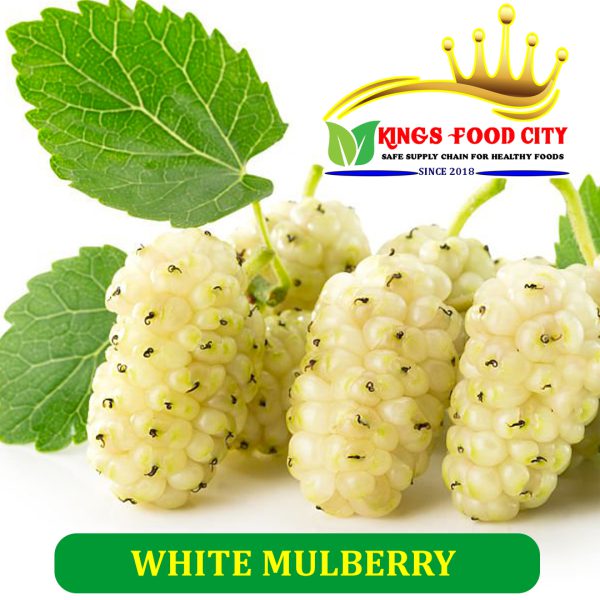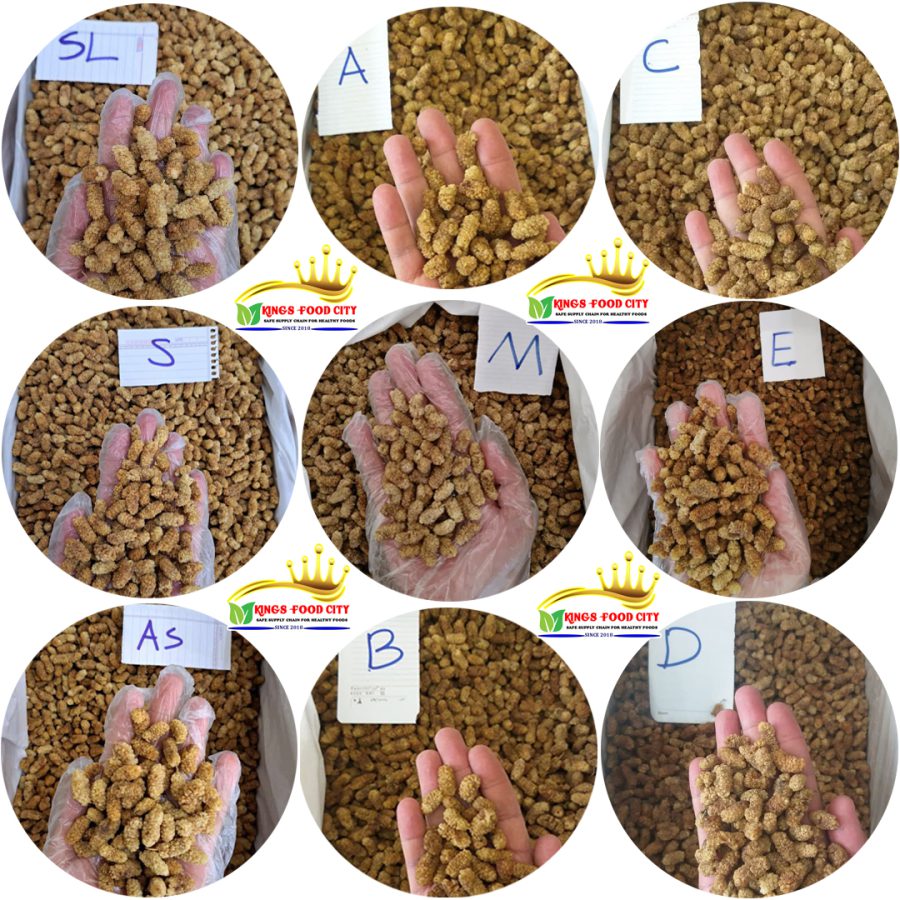Dried Mulberry
The history of mulberry fruit is as rich and diverse as the fruit itself! Mulberries, from the Morus genus, have a long and illustrious history dating back thousands of years across various cultures.
In Ancient Greece, mulberries were praised in writings by Theophrastus (371–287 BC) for their delightful taste and perceived health benefits. They were esteemed and enjoyed, becoming a part of the Mediterranean culinary heritage. Moving to Asia, particularly China, mulberries had a significant and multifaceted role in history. Not only were the fruits appreciated for their flavor and used in traditional Chinese cuisine, but their leaves were also crucial to the silk industry. The leaves of the mulberry tree were the primary food source for silkworms, supporting the production of silk, a vital industry in China for centuries. The Romans also cherished mulberries. They were introduced to Britain during the Roman era and were cultivated during the Middle Ages. Mulberry trees were coveted and grown in royal and aristocratic gardens, reflecting their status as a prestigious fruit. In the 17th century, efforts were made to cultivate mulberries for the silk industry. King James I of England promoted the planting of mulberry trees to support the silkworm trade, although the venture ultimately did not achieve the hoped-for success. And let's not forget that in the modern day, mulberries continue to be celebrated for their unique taste and versatility, being used in jams, desserts, and even wines.
the tradition of drying mulberries dates back to ancient times. In Eastern cultures, the drying process was used to preserve the berries for consumption during the off-season. The dried mulberries were often used in traditional Chinese medicine as well as a source of nourishment and sustenance when fresh fruits were scarce. The popularity of dried mulberries extended to regions such as the Mediterranean, where the fruits were valued for their natural sweetness and were commonly dried to prolong their shelf life. The dried version of mulberries became a staple in the diets of various civilizations throughout history. In modern times, the popularity of dried mulberries has grown significantly as a result of their health benefits and unique taste. They are renowned for their high levels of vitamins, minerals, and antioxidants. This has led to an increased demand for dried mulberries in health-conscious and gourmet food markets around the world.
In Ancient Greece, mulberries were praised in writings by Theophrastus (371–287 BC) for their delightful taste and perceived health benefits. They were esteemed and enjoyed, becoming a part of the Mediterranean culinary heritage. Moving to Asia, particularly China, mulberries had a significant and multifaceted role in history. Not only were the fruits appreciated for their flavor and used in traditional Chinese cuisine, but their leaves were also crucial to the silk industry. The leaves of the mulberry tree were the primary food source for silkworms, supporting the production of silk, a vital industry in China for centuries. The Romans also cherished mulberries. They were introduced to Britain during the Roman era and were cultivated during the Middle Ages. Mulberry trees were coveted and grown in royal and aristocratic gardens, reflecting their status as a prestigious fruit. In the 17th century, efforts were made to cultivate mulberries for the silk industry. King James I of England promoted the planting of mulberry trees to support the silkworm trade, although the venture ultimately did not achieve the hoped-for success. And let's not forget that in the modern day, mulberries continue to be celebrated for their unique taste and versatility, being used in jams, desserts, and even wines.
the tradition of drying mulberries dates back to ancient times. In Eastern cultures, the drying process was used to preserve the berries for consumption during the off-season. The dried mulberries were often used in traditional Chinese medicine as well as a source of nourishment and sustenance when fresh fruits were scarce. The popularity of dried mulberries extended to regions such as the Mediterranean, where the fruits were valued for their natural sweetness and were commonly dried to prolong their shelf life. The dried version of mulberries became a staple in the diets of various civilizations throughout history. In modern times, the popularity of dried mulberries has grown significantly as a result of their health benefits and unique taste. They are renowned for their high levels of vitamins, minerals, and antioxidants. This has led to an increased demand for dried mulberries in health-conscious and gourmet food markets around the world.

Persian Dried Mulberry
Persian dried mulberries are a delightful and nutrient-rich treat that carries a deep cultural and historical significance. These dried mulberries have been cherished in Persian cuisine for centuries and continue to be appreciated for their unique properties and health benefits. Persian dried mulberries are typically grown in regions with favorable climates. The berries are carefully harvested at the peak of ripeness before being sun-dried, preserving their natural sweetness and nutritional value. The berries are hand-picked and dried, ensuring a high-quality product with an exquisite flavor profile. These dried mulberries boast a sweet and slightly tart flavor, often described as reminiscent of figs and raisins. They have a chewy texture, which makes them a delightful addition to various culinary creations. The rich taste and chewy texture make them a favorite ingredient in both sweet and savory dishes, adding a distinct flavor and nutritional boost.
The grading of dried mulberries is crucial for ensuring consistent quality and meeting market demands. Grading helps to categorize the dried mulberries based on various characteristics, such as size, color, and overall appearance.
Size Grading: One of the key factors in grading Persian dried mulberries is their size. The berries are typically graded into different categories based on their diameter. Larger berries are often considered to be of higher quality and may command a premium price due to their perceived desirability. Size grading ensures that customers receive dried mulberries that meet their expectations in terms of size and visual appeal.
Color Grading: Color is another essential aspect when grading Persian dried mulberries. The berries are evaluated based on their color spectrum, which can range from bright, vibrant shades to deeper, darker hues. Consistency in color is important, and the grading process aims to ensure that the dried mulberries within each grade exhibit uniform coloration. Brighter and more uniform colors are generally associated with superior quality and are often preferred in the market.
Additional Criteria: In addition to size and color, other factors may also play a role in the grading of Persian dried mulberries. This may include the absence of foreign matter, the overall condition of the berries, and the level of moisture content. By considering these additional criteria, graders can further refine the quality assessment of the dried mulberries, ensuring that only the finest products reach consumers.
Size Grading: One of the key factors in grading Persian dried mulberries is their size. The berries are typically graded into different categories based on their diameter. Larger berries are often considered to be of higher quality and may command a premium price due to their perceived desirability. Size grading ensures that customers receive dried mulberries that meet their expectations in terms of size and visual appeal.
Color Grading: Color is another essential aspect when grading Persian dried mulberries. The berries are evaluated based on their color spectrum, which can range from bright, vibrant shades to deeper, darker hues. Consistency in color is important, and the grading process aims to ensure that the dried mulberries within each grade exhibit uniform coloration. Brighter and more uniform colors are generally associated with superior quality and are often preferred in the market.
Additional Criteria: In addition to size and color, other factors may also play a role in the grading of Persian dried mulberries. This may include the absence of foreign matter, the overall condition of the berries, and the level of moisture content. By considering these additional criteria, graders can further refine the quality assessment of the dried mulberries, ensuring that only the finest products reach consumers.

Dried mulberries are classified into the following grades based on color, size, moisture content and appearance as following:
Premium Grades: SL, S
First Grade: AS, A, M, B
Second Grade: C, D, E
Premium Grades: SL, S
First Grade: AS, A, M, B
Second Grade: C, D, E
Health and Nutritional Benefits of Dried Mulberry
Dried mulberries pack quite the nutritional punch, offering a range of health benefits that make them a fantastic addition to a balanced diet.
Rich in Antioxidants: Dried mulberries are loaded with antioxidants such as resveratrol, anthocyanins, and flavonoids. These compounds help combat oxidative stress, reduce inflammation, and may play a role in lowering the risk of chronic diseases, including heart disease and certain types of cancer.
Excellent Source of Vitamin C: These little berries are a great source of vitamin C, which is essential for supporting the immune system, promoting skin health, and aiding in iron absorption. Vitamin C also acts as an antioxidant, protecting the body from damage caused by free radicals.
Dietary Fiber: Dried mulberries are high in dietary fiber, which aids in digestion, promotes gut health, and helps regulate blood sugar levels. Consuming foods high in fiber can also support weight management by promoting a feeling of fullness.
Iron and Vitamin K: Dried mulberries contain notable amounts of iron and vitamin K. Iron is crucial for energy production and optimal oxygen transport in the body, while vitamin K plays a role in blood clotting and bone health.
Low Glycemic Index: Dried mulberries have a relatively low glycemic index, which means they cause a slower and more gradual rise in blood sugar levels compared to high-glycemic foods. This can be beneficial for individuals looking to manage their blood sugar levels.
Plant Compounds: Dried mulberries contain plant compounds such as resveratrol, which has been linked to potential benefits for heart health, brain function, and longevity.
Rich in Antioxidants: Dried mulberries are loaded with antioxidants such as resveratrol, anthocyanins, and flavonoids. These compounds help combat oxidative stress, reduce inflammation, and may play a role in lowering the risk of chronic diseases, including heart disease and certain types of cancer.
Excellent Source of Vitamin C: These little berries are a great source of vitamin C, which is essential for supporting the immune system, promoting skin health, and aiding in iron absorption. Vitamin C also acts as an antioxidant, protecting the body from damage caused by free radicals.
Dietary Fiber: Dried mulberries are high in dietary fiber, which aids in digestion, promotes gut health, and helps regulate blood sugar levels. Consuming foods high in fiber can also support weight management by promoting a feeling of fullness.
Iron and Vitamin K: Dried mulberries contain notable amounts of iron and vitamin K. Iron is crucial for energy production and optimal oxygen transport in the body, while vitamin K plays a role in blood clotting and bone health.
Low Glycemic Index: Dried mulberries have a relatively low glycemic index, which means they cause a slower and more gradual rise in blood sugar levels compared to high-glycemic foods. This can be beneficial for individuals looking to manage their blood sugar levels.
Plant Compounds: Dried mulberries contain plant compounds such as resveratrol, which has been linked to potential benefits for heart health, brain function, and longevity.
Culinary Usages of Dried Mulberries
Dried mulberries, as a naturally dried fruit, offer a delightful and nutritious snacking option, and there are numerous ways to incorporate them into your daily diet.
Snacking: Dried mulberries make for a delicious and nutritious snack on their own. Their sweet and slightly tart flavor, along with their chewy texture, makes them a satisfying and convenient snack option.
Trail Mixes and Granola: Add dried mulberries to homemade trail mixes, granola bars, or granola blends to infuse a fruity sweetness and an extra nutritional boost. They pair well with nuts, seeds, and other dried fruits to create a wholesome and energy-packed snack.
Baking and Desserts: Dried mulberries can be incorporated into a variety of baked goods and desserts. Add them to muffins, cookies, breads, cakes, and fruit bars for a pop of sweetness and texture. They also work well in fruit compotes and crisps, providing a tasty and nutritious addition.
Breakfast Bowls: Sprinkle dried mulberries over oatmeal, cereal, or yogurt for a delightful and nutrient-rich addition to your breakfast. They can bring a burst of flavor to your morning routine and add an interesting texture to your favorite breakfast bowls.
Salads and Savory Dishes: Dried mulberries can be used to add a touch of sweetness and texture to salads, grain dishes, and savory creations. They work well in salads with leafy greens or grain-based salads, offering a pleasant contrast to other ingredients.
Hot and Cold Beverages: Infuse dried mulberries into teas, hot cocoa, or smoothies to add a fruity twist. They can be a great addition to homemade fruit-infused water or cold beverages, enhancing both the flavor and visual appeal.
Homemade Bars and Energy Bites: Incorporate dried mulberries into homemade energy bars, protein bars, or energy bites. Their natural sweetness and chewy texture make them a fantastic ingredient for creating customized, nutrient-dense snacks.
Sauces and Chutneys: Create flavorful sauces, chutneys, or relishes with dried mulberries to complement savory dishes such as poultry, pork, or lamb. Their sweet and tangy flavor can add depth to sauces and bring a unique element to the overall dish.
Snacking: Dried mulberries make for a delicious and nutritious snack on their own. Their sweet and slightly tart flavor, along with their chewy texture, makes them a satisfying and convenient snack option.
Trail Mixes and Granola: Add dried mulberries to homemade trail mixes, granola bars, or granola blends to infuse a fruity sweetness and an extra nutritional boost. They pair well with nuts, seeds, and other dried fruits to create a wholesome and energy-packed snack.
Baking and Desserts: Dried mulberries can be incorporated into a variety of baked goods and desserts. Add them to muffins, cookies, breads, cakes, and fruit bars for a pop of sweetness and texture. They also work well in fruit compotes and crisps, providing a tasty and nutritious addition.
Breakfast Bowls: Sprinkle dried mulberries over oatmeal, cereal, or yogurt for a delightful and nutrient-rich addition to your breakfast. They can bring a burst of flavor to your morning routine and add an interesting texture to your favorite breakfast bowls.
Salads and Savory Dishes: Dried mulberries can be used to add a touch of sweetness and texture to salads, grain dishes, and savory creations. They work well in salads with leafy greens or grain-based salads, offering a pleasant contrast to other ingredients.
Hot and Cold Beverages: Infuse dried mulberries into teas, hot cocoa, or smoothies to add a fruity twist. They can be a great addition to homemade fruit-infused water or cold beverages, enhancing both the flavor and visual appeal.
Homemade Bars and Energy Bites: Incorporate dried mulberries into homemade energy bars, protein bars, or energy bites. Their natural sweetness and chewy texture make them a fantastic ingredient for creating customized, nutrient-dense snacks.
Sauces and Chutneys: Create flavorful sauces, chutneys, or relishes with dried mulberries to complement savory dishes such as poultry, pork, or lamb. Their sweet and tangy flavor can add depth to sauces and bring a unique element to the overall dish.

